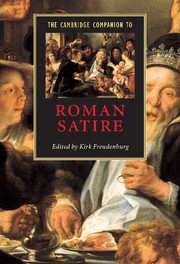Book contents
- Frontmatter
- Introduction
- Part I Satire as literature
- 1 Rome’s first “satirists”
- 2 The restless companion
- 3 Speaking from silence
- 4 The poor man’s feast
- 5 Citation and authority in Seneca’s Apocolocyntosis
- 6 Late arrivals
- 7 Epic allusion in Roman satire
- 8 Sleeping with the enemy
- 9 The satiric maze
- Part II Satire as social discourse
- Part III Beyond Rome
- Conclusion
- Key dates for the study of Roman satire
- Bibliography
- Index
- Series list
7 - Epic allusion in Roman satire
from Part I - Satire as literature
Published online by Cambridge University Press: 28 May 2006
- Frontmatter
- Introduction
- Part I Satire as literature
- 1 Rome’s first “satirists”
- 2 The restless companion
- 3 Speaking from silence
- 4 The poor man’s feast
- 5 Citation and authority in Seneca’s Apocolocyntosis
- 6 Late arrivals
- 7 Epic allusion in Roman satire
- 8 Sleeping with the enemy
- 9 The satiric maze
- Part II Satire as social discourse
- Part III Beyond Rome
- Conclusion
- Key dates for the study of Roman satire
- Bibliography
- Index
- Series list
Summary
One of the things Lucilius, Horace, Persius, and Juvenal have in common is their pleasure in a nice bit of epic furniture about the place. It is easy enough to install, since epic and satire both use the dactylic hexameter. It is fun to hear Horace describe the city mouse and the country mouse going to Rome in the kind of night that falls in Roman epic (Horace, Sermones 2.6.98-101). It is amusing to see a decadent Roman aristocrat as a “boy Automedon” (Achilles' charioteer, Juvenal 1.61), or to see the admirable Pyrrha, who helps repopulate the earth after the flood by throwing stones over her shoulder, through Juvenal’s jaundiced eyes, looking like a procuress setting out her girls (Juvenal 1.84). And of course everyone enjoys a nice swipe at bad epic poets now and then. But the function of epic allusion in Roman satire should not be understood as exclusively decorative. In many genres, poets use allusions to define their poetic projects and to articulate important themes. It is well understood that the Roman satirists use allusions to or descriptions of their satiric predecessors to articulate their poetic projects. What has been less appreciated is how precisely each poet chooses his allusions to epic to define his poetic project and its political dimension.
- Type
- Chapter
- Information
- The Cambridge Companion to Roman Satire , pp. 123 - 145Publisher: Cambridge University PressPrint publication year: 2005
- 15
- Cited by



